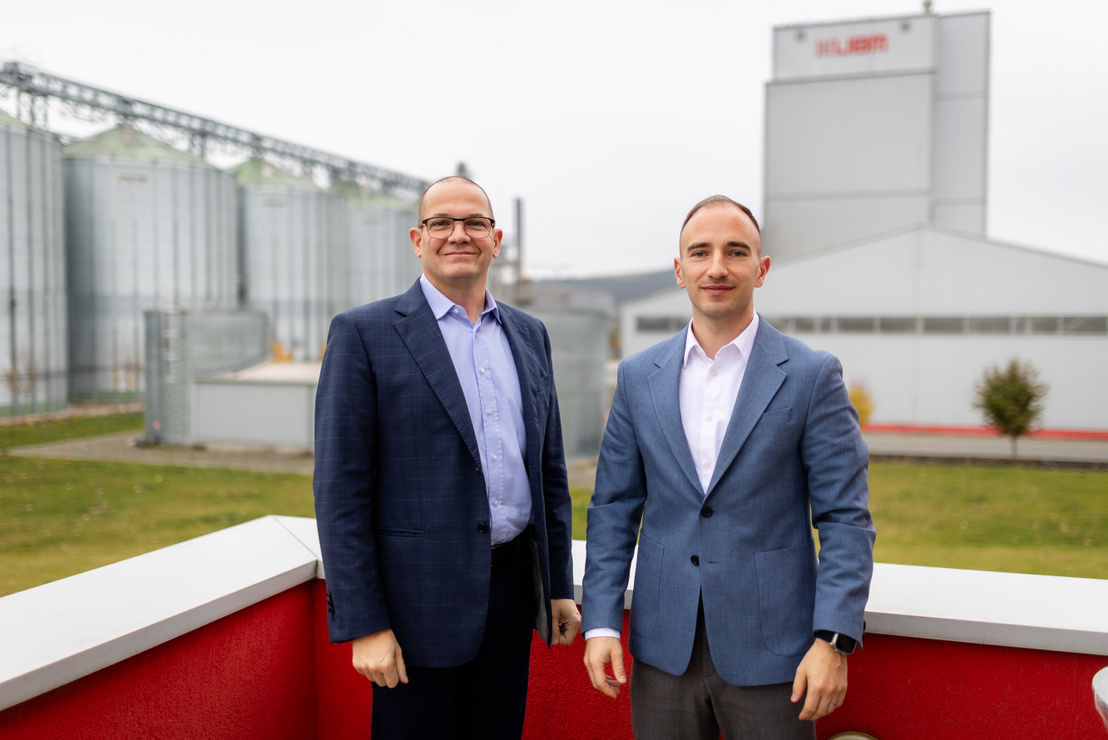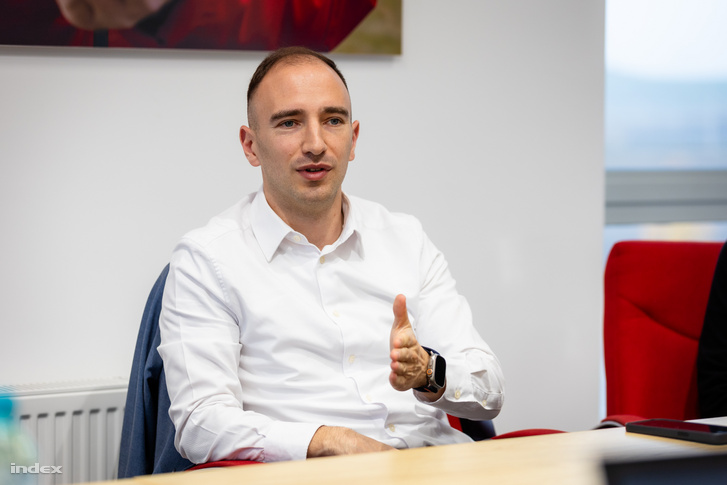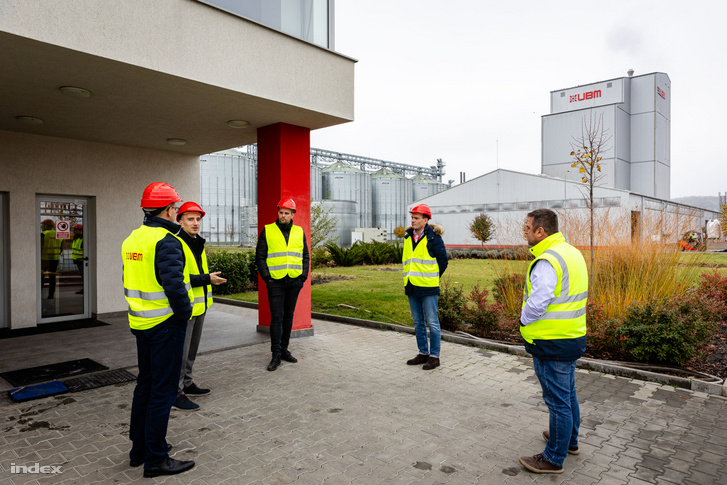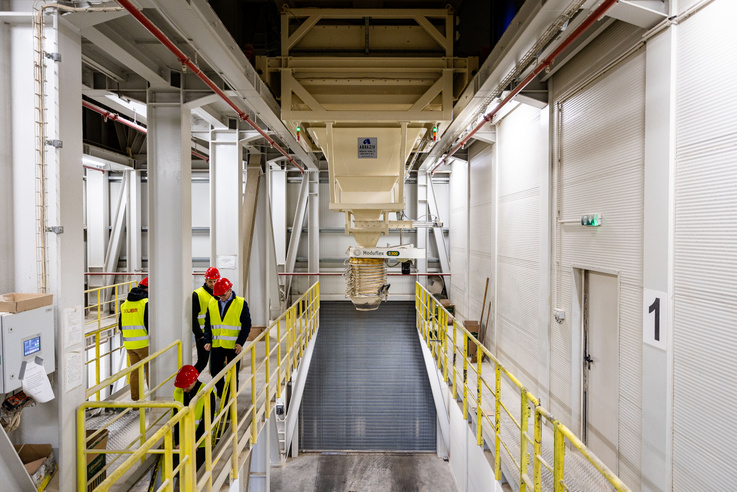One must always eat: Hungary can be European champion again in one of the most important industries
There is huge potential in the agricultural sector of Central and Eastern Europe, and Hungary can play a central role in its development, executives of Hungary’s market leading feed manufacturing company told Index. UBM would also become a more prominent player in the EU market, while according to the company Hungary has all the potential to return to where it was decades ago in terms of agriculture, i.e., at the top of the continent.
Perhaps few people may know, but Kerelőszentpál, near Marosvásárhely (Târgu Mures), is home to one of the largest feed factories in Central and Eastern Europe, and it is in Hungarian ownership. Founded in 1996, UBM has grown over the past 28 years to become one of Hungary’s leading agricultural companies, our country’s leading feed producer and one of the largest traders of feed raw materials in Hungary. The group has conquered the domestic market and established a foothold also beyond our borders, and started its plant in Slovakia besides a factory unit in Romania, and its sales offices are present in several Western European markets.
UBM’s history in Kerelőszentpál dates back to 2015. This classic greenfield investment was inspired mainly by the need to save huge logistics costs. Indeed, producing feed locally is significantly more cost-effective than transporting it hundreds of kilometres. “It is a general trend in Western Europe that feed does not travel more than 150 kilometres, and we set up the Romanian plant with this in mind,” says Dénes Laczkó, Managing Director of UBM Feed Romania.
Hungarian know-how is a market advantage
With a total investment of some EUR 15.6 million, Romania’s largest independent feed mixing plant was constructed in Kerelőszentpál. „The plant fills a gap, and its establishment was justified by the market potential of the country, especially in the Transylvanian region,” as Dénes Laczkó put it.
Dénes Laczkó
Gallery: The UBM feed factory in Kerelőszentpál
Photo by Péter Papajcsik / Index
The plant produces and distributes high-quality feed for poultry, pigs and ruminants to several Transylvanian and Transcarpathian counties. With an hourly capacity of 30 tonnes and a capacity of 220,000 tonnes a year, it is one of the largest feed production facilities in the region and one of the most modern in Europe. This production capacity entails an annual demand of around 130,000-140,000 tonnes of cereals in terms of raw materials. Besides, the region’s livestock sector is on a sound development path, coupled with a growing demand for feed.
THE IMPORTANCE OF UBM’S PRESENCE IN ROMANIA IS WELL ILLUSTRATED BY THE FACT THAT THE NEIGHBOURING COUNTRY HAS A TOTAL ANNUAL FEED PRODUCTION CAPACITY OF 2.8 MILLION TONNES, OF WHICH THE PLANT IN KERELŐSZENTPAL ACCOUNTS FOR ALMOST 8 PER CENT.
„In 2023, we produced some 150,000 tonnes of feed, which represented a business turnover of EUR 60 million and a pre-tax profit of EUR 1.5 million,” said Dénes Laczkó.
The production line is accompanied by an automatic bagging and palletising system, so the plant can supply customers with products in bulk or in different bag package sizes. Bagged products are therefore also available for feeding domestic livestock. „As the market leader in Hungary, the UBM Group has a wealth of knowledge of the sector that provides an advantage over its Romanian competitors. The geographical positioning is no coincidence either. Indeed, all corners of Romania are accessible from Kerelőszentpál with the final product. In addition, it is a region rich in agricultural activity and arable land, which provides a good raw material market for the production of feed,” the Managing Director of the Hungarian subsidiary of the UBM Group in Romania pointed out.
Gallery: The UBM feed factory in Kerelőszentpál
Photo by Péter Papajcsik / Index
Although UBM sells its feed mixes at prices higher than average, that is also accompanied by higher quality.
„Better quality is reflected in higher specific rates. The specific rate shows the number of kgs of live meat that can be produced from one kg of feed. In the case of broiler chickens, 1.6 to 1.7 kg of feed were used to produce 1 kg of meat, in line with previous market trends, or in other words, 42 days passed from day-old chicken to slaughter, which means that a broiler cycle lasted 6 weeks. Compared to this, UBM has reduced the amount of feed required to produce 1 kg of live meat to 1.5 kg, and reduced the cycle to 38 days with its high-quality feed mixes. And this enables producers to incorporate an additional half-whole rotation at annual level into their breeding, and the 15-20 dkg feed savings per kg also mean a lot to them in terms of profitability,”
Dénes Laczkó summed up.
Feed accounts for almost half of the price of chicken breasts on the shop shelves, which is why it is important to know what feed is available for producers at what cost and with what efficiency. It is important to highlight that less feed used does not in any way mean a reduction in meat quality, thanks to the fact that UBM mixes are produced under strict rules that guarantee high quality.
“If they don’t let us go, there will be no chicken in the shops next week”
The UBM team in Romania trained at the right time, Dénes Laczkó pointed out with an illustrative example. After the start of production in May 2019, the Covid pandemic and then the Russian-Ukrainian war hit very soon.
Although there was a complete curfew in Romania during the pandemic we, as a food company, were granted a special permit to continue production and related logistics activities in Romania, subject to strict rules. In the case of poultry, even a few days’ loss of feed can result in the death of the animals. The importance of feed is illustrated by the fact that when police stopped our colleagues on their way to the factory for the umpteenth time, I called their attention that if they did not let us go, the chicken meat could run out in the shops even within days,
he added.
The surge in energy prices after the outbreak of the war between Russia and Ukraine did not help the company either, but by installing a solar panel system, e.g., they were able to reduce energy consumption and thus costs.
Gallery: The UBM feed factory in Kerelőszentpál
Photo by Péter Papajcsik / Index
The Index crew had the opportunity to take a look at the works at the Romanian plant. Almost everything is digitalised and automated, as a result of which only three people per shift are involved in continuous, 24-hour production. „Not only are we unique in the region, but we are also in the top 5 in Europe in terms of the technical content of the factory. At the next level, we are already working on integrating artificial intelligence into production,” points out Dénes Laczkó.
From lagging behind to growth potential
UBM’s Romanian subsidiary looks to the future with high expectations. This is because Romania is an EU great superpower in grain – with an annual volume of 30 million tonnes, two-thirds of which is exported – and the country’s livestock sector is also facing a huge boom. The industry expects the centre of gravity of livestock production to shift from Western to Central and Eastern Europe where, as livestock farming becomes more concentrated, there will be an increasing demand for quality feed produced on a large scale using good technology. From a crop production point of view – and therefore also from a feed material point of view – the situation is ideal, as many raw materials are available at low prices.
“However, in terms of added value, there are still huge shortcomings in the Romanian agricultural, livestock and food chain, which is why the country is an exporter of raw materials and an importer of added value. These shortcomings, however, also represent a huge potential for UBM, as the group can disseminate the most advanced technology and know-how in Central and Eastern European countries, which are 10-20 years behind in the field of feed mixing technologies, through its R&D activities, which cost several hundred million forints a year,” said Dénes Laczkó.
As the Managing Director put it, the huge industrial potential of the neighbouring country is well illustrated by the fact that while Romania produces 2.8 million tonnes of feed annually, Hungary, which is one third the size of Romania, produces 3.5-3.8 million tonnes. „What needs to be done is to reallocate resources to local production capacities instead of huge transport costs. Romania is a very strong producer of raw materials, so the opportunity is given to turn the steering bar towards local feed and food production,” said Dénes Laczkó.
The way for digitisation must be paved
It is, however, not only in the neighbourhood that there is plenty of room for growth. According to an announcement by Minister of Agriculture István Nagy last November, the government will spend some HUF 4,300 billion on the development of domestic agriculture, the food industry and rural settlements by 2027. „When spending the subsidies, companies should focus mainly on developments in the field of digitisation,” this was said to our paper already by Péter Horváth, CEO of UBM Hungary, adding that the development varies from sector to sector. While digitisation is more advanced in companies involved in crop production, livestock farmers have some catching up to do. „The operating model to be followed in Hungary is the same as the one already implemented at our subsidiary in Kerelőszentpal, i.e. achieving high production capacity through automation and robotisation,” the CEO pointed out. This process could be partly a response to the labour force shortage in agriculture.
Increasing efficiency in productivity could be a key issue for the food industry of the future, as the world’s population is projected to grow sharply in the coming decades, to more than 10 billion people. According to Péter Horváth, in addition to
the relocation of production capacities to our region in the coming years, the rapid population growth will also lead to an increase in poultry and pork consumption by about 10 percent. And the food industry must be ready for these developments.
They would push the boundaries
The value of Hungarian agricultural exports has grown dynamically in recent years, but the bulk of exports still go to the European Union, including Germany, Italy and Romania. Although UBM now exports to 15 countries, in their case exports are still mainly destined for Italy, Romania and Austria. Domestic sales still account for a slightly larger share of the company’s results – 44 percent of turnover in the recently closed financial year came from exports – but the aim is to increase this proportion to over 50 percent on a sustainable basis. Precisely for this reason, the group would like to be present not only in its home market, but also in other cross-border markets.
Thus, the company is also busy with investments looking for investment and acquisition opportunities in the region in anticipation of the dynamic growth outlined above, focusing mainly on Romania, Serbia and the Western Balkans, but despite the difficulties, it also sees potential in the Ukrainian market.
Moreover, the political will to invest is also there. Indeed, in order to improve the profit balance, the government would like to see more foreign investment by domestic firms. At present, foreign companies are still generating more than six billion euros more profit in Hungary than Hungarian companies abroad. „We are able to gain market advantage from the level of technology that UBM has. We have a 10-15 year advantage over our competitors, and if we can maintain that advantage, we ‘only’ need to concentrate on timing, so that when more and more livestock farms start operating in the regional markets we should already be there with feed in our hands,” said Péter Horváth.
Péter Horváth
Gallery: The UBM feed factory in Kerelőszentpál
Photo by Péter Papajcsik / Index
The question is, however, what feed prices livestock farmers can expect in the period ahead. The price of cereals, the main raw material for animal feed, peaked in January last year, ending a price rise cycle that lasted for about 3 years. Since then prices have consolidated significantly, with world grain prices more than 50% cheaper compared to that a year earlier. „This is also a problem on the other side, as a continuous production plant, we need to ensure that stocks are available. Starting from this, we made a loss on the lower-priced feed produced from the grain we bought at a high price, which was reflected in the HUF 1.5 billion after-tax result for the previous financial year,” said Péter Horváth, who expects that the price of grain have reached the bottom and will stop going down further from current levels.
UBM Holding Nyrt. closed its financial year from 1 July 2022 to 30 June 2023 with record sales revenues and EBITDA (earnings before interest, taxes, depreciation and amortisation): in the last closed financial year, the Group achieved consolidated sales revenues of HUF 231.6 billion and EBITDA of HUF 9.6 billion. In the closed business year, the Group invested EUR 5.9 million to modernise its plant with an annual capacity of 88,000 tonne in Slovakia and HUF 1.2 billion to reconstruct its mixing plant in Szeleste, increasing its production capacity to an annual 200,000 tonnes. In addition, the Group also continued its expansion in Romania. UBM will continue its regional expansion and develop its logistics infrastructure, building Europe’s most modern and sustainable pig farm by 2026 and expanding its continental trading activities. By achieving these objectives, the UBM Group’s sales revenues are expected to reach HUF 350 billion by 2026.
A challenging financing leg
Investments enhancing growth have been hampered by the significant deterioration in the financing environment from the second half of 2022 onwards. In a significantly higher interest rate environment from the second half of 2023, agricultural businesses have also found it harder to raise finance for their investments and development.
I don’t see too many farms and factories being able to operate effectively with 20 per cent bank financing. However, I am optimistic: all the signs point to the fact that inflation could be around 6-7 per cent by the middle of this year, and interest rates will fall accordingly. Such a financing environment would already allow us to achieve a reasonable margin,
said Péter Horváth, adding that this is why UBM sought and found other ways to raise capital. In the summer of 2022, the venture capital investor Hiventures joined the owners behind the company, thanks to which a HUF 5 billion capital increase was executed, enabling the feed producer to finance investments and acquisitions.
Gallery: The UBM feed factory in Kerelőszentpál
Photo by Péter Papajcsik / Index
UBM is strongly committed to expanding its institutional and private investor base. According to Péter Horváth, the financial markets do not always reflect the importance of the agricultural sector. „We want to be pioneers in this field. Our aim is to present to the capital market, through the operation of UBM, that agriculture is a sector that produces stable results in the long term,” he explained.
In addition to its recently published annual report, UBM has also published its first ESG (Environment, Social, Governance) report, in which it is also ahead of its competitors. This is also necessary to develop a framework for green finance, as, e.g., the issue of green bond can be used to finance investments and acquisitions at interest rates well below current levels. However, they must meet stringent sustainability requirements, which is important because agriculture is the largest emitter of greenhouse gases, alongside the energy sector and logistics.
According to Péter Horváth, the future of the industry lies in the triangle of digitisation, sustainability and carbon neutrality, as agriculture is an increasingly knowledge-intensive sector. These are aspects that cannot be left out of UBM’s research and development policy, which is why the company invests hundreds of millions of forints a year in R&D activities. The CEO also gave a concrete example: the possibility of developing feed formulas to reduce methane emissions from cattle should be explored.
Back to the top of the continent
Hungary has traditionally been a strong agricultural country, and we should revive this tradition in order to return to the forefront of European agriculture. When we joined the EU, France and the Netherlands still had reason to fear that the emergence of Hungarian agriculture would give them a serious competitor, but this did not happen in the end, because Hungarian agriculture has suffered a serious downturn in the past two decades, Péter Horváth recalled. Although we have no sea, we do have good land, plenty of sunshine and water, yet this potential is far from being tapped.
Péter Horváth (left) and Dénes Laczkó (right)
Gallery: The UBM feed factory in Kerelőszentpál
Photo by Péter Papajcsik / Index
Agriculture is in the blood of Hungarians, but we need a mental reform of society to say that pigs are not stinky, that it is not pejorative to engage in agriculture, to work the land, and if we have the talent for it, we must take advantage of it, because no matter what war comes, we must always eat.
the CEO explained, who also pointed out that although agricultural companies are less inclined to go public, this is one of the most stable sectors in terms of investment. It is no coincidence that in the past year, UBM has added a number of institutional and private investors to its shareholder base, with shares currently trading at around HUF 1,500 on the Budapest Stock Exchange.
If you have any questions, please do not hesitate to contact us at investors@ubm.hu.










